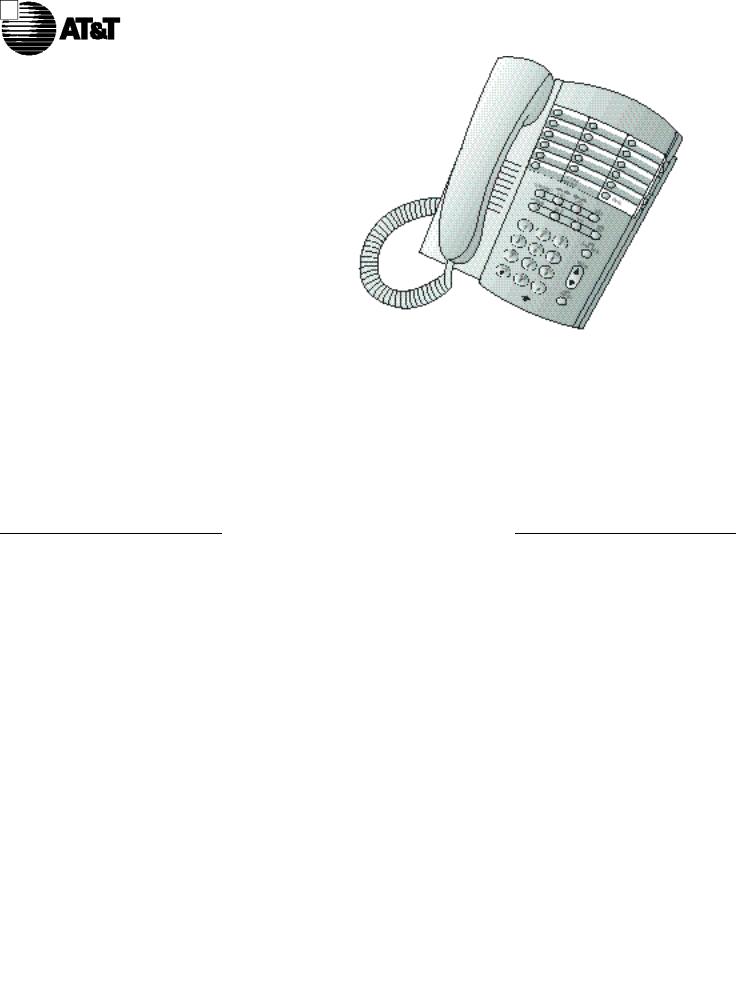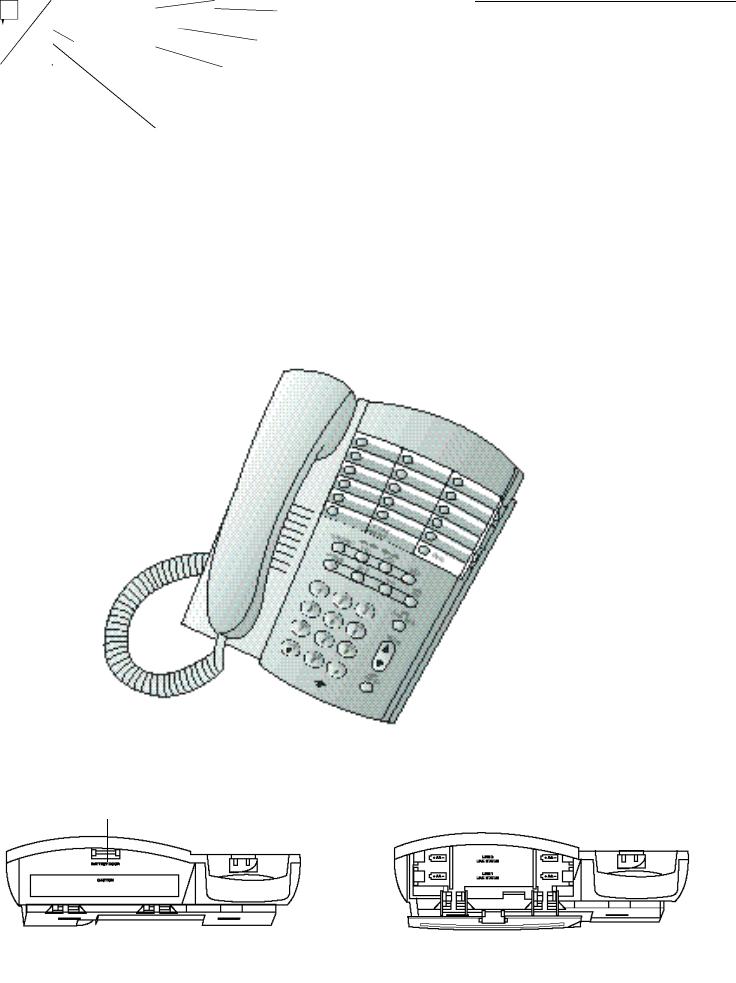AT&T 922 User Manual

User’s Manual for the
Two-Line Speakerphone 922
Fold open this manual for information about this telephone’s installation and operation. Please read Part 1 — Important Product Information, included in this package.
Part 2
© 1998 Philips Consumer Communications, L.P. All rights reserved. Printed in Mexico. 848235974 Issue 1AT&T
IN CASE OF DIFFICULTY
•Try calling the number you want
to enter into memor y. When the call is ended, press  ,
,  and a memory button.
and a memory button.
•If someone lifts an extension phone while you are storing numbers in memory, programming might be interrupted. Make sure all extensions are on hook while storing numbers in memory.
•You might not hear the confirmation beep if the RECEIVER (handset) volume is set too low, or if you are in a noisy location.
•If the number is more than 24 digits long, make sure you follow the directions for “Dialing Long Numbers.”
•Do not put the phone on Hold while storing numbers.
Problems With Line Status Lights
•Make sure all plugs are connected properly. Inspect the line cord connections at the modular jack and at the telephone . Also inspect the coiled handset cord connections at both ends.
•Try replacing old batteries. See “Batteries” in the Installation section.
•Make sure the batteries are correctly installed, and that the battery contact surfaces and battery case are clean.
•If only one telephone line is connected, make sure that only the batteries for that line (as labeled on the battery compartment) are installed.
Telephone Does Not Ring
•Make sure the RINGER switch is set in the LO or HI position.
•If there are several other telephones on the same line, try disconnecting some of the other telephones. Having too many telephones connected can also create problems such as low ringer volume, or impaired sound quality during calls.
Other Problems
Make sure you have followed all the instructions in this booklet. If you continue to have problems, call
1 800 722-9125. If you cannot correct the problem, disconnect the telephone and refer to the warranty information.
6

INSTALLATION
NOTE: This telephone requires a 2-line modular jack or two separate one-line modular jacks to use this unit as a two-line phone.
NOTE: To use both lines of a twoline telephone, your local telephone company must provide two telephone numbers.
Batteries
NOTE: The base must be removed to install batteries.
Before using the telephone, you should install AA batteries (not included). If you are connecting only Line 1 or only Line 2, use two batteries, as indicated on the bottom of the phone. If you are connecting both lines, use four batteries.
You can use the phone without batteries to make and receive calls, but it requires batteries to power the Line Status lights.
If you have wall-mounted the telephone, follow these directions:
1Remove the telephone from the wall.
2Turn the telephone upside down.
3Remove the base by pressing the tabs located on the top of the base.
4Press down on tab on battery door located between arrows on battery door (Figure 2A). Swing door open and insert new batteries (Figure 2B).
5Close the battery door.
CAUTION: Always unplug the line cord before installing new AA batteries.
|
Directory Card/Cover |
Accesses memory |
One-Touch |
||||
|
|
Line Status |
numbers |
Memory Locations |
|||
|
|
|
|
Two Touch |
|||
|
|
Lights |
|
|
|||
|
|
|
|
|
|
Memory Locations |
|
|
|
Line selection |
|
|
|
||
Programs a number |
Conferences |
|
|
Line 2 Ringer Volume |
|||
|
|
|
|||||
in memory |
both lines |
|
|
Accesses two-touch |
|||
Programs a pause |
|
|
|
|
|
||
|
|
|
|
|
memory dialing numbers |
||
in memory |
|
|
|
|
|
||
|
|
|
|
|
|
||
Access Call Waiting |
|
|
|
|
|
Line 1 Ringer Volume |
|
|
|
|
|
|
|||
or other services |
|
|
|
|
Puts a call on hold |
||
|
|
|
|
|
|
||
Handset |
|
|
|
|
|
Mutes a call |
|
|
|
|
|
|
|||
|
|
|
|
|
|
||
|
|
|
|
|
|
Redials last call made, or starts Auto Redial |
|
Temporary |
|
|
|
Speaker/Handset Volume |
|||
Tone |
|
|
|
||||
|
|
|
|
|
|
||
|
|
|
|
|
Turn speaker on or off |
||
|
|
|
|
Figure 1 |
|||
|
|
|
|
|
|
|
|
Press down on tab to |
BATTERY DOOR CLOSED, |
Insert two |
BATTERY DOOR OPEN, |
|
AA batteries for Line 2 |
||||
open battery door |
BASE OFF |
BASE OFF |
||
|
Figure 2A |
|
Figure 2B |
Insert two AA batteries for Line 1
1

Table
1Remove the base.
2Connect line cord(s) to telephone.
•If you have a two-line jack, use only the line cord with the clear modular plugs on each end. Plug one end into the jack labeled L1 OR L1/2 on the bottom of the telephone.
•If you have two separate jacks, use both line cords. Insert one end of the cord with the clear plugs into the jack labeled L1 OR L1/2 on the bottom of the telephone. Insert one end of the cord with the blue plugs into the jack labeled L2 on the bottom of the telephone.
3Attach the base.
Turn the base so that the larger end of the base is toward the top of the telephone. Attach the base by inserting the tabs into the slots. Push down on the large end of the base to lock it into place.
4Connect the line cord(s) to your modular jack(s).
•If you have a two-line jack, plug the free end of the line cord into a modular baseboard jack. Make sure the cord snaps firmly into place.
•If you have two separate jacks, plug the free end of the cord with the blue plugs into the modular jack for Line 1. Plug the free end of the cord with the clear plugs into the modular jack for Line 2. Make sure the cords snap firmly into place.
5Connect handset to telephone.
Plug the coiled cord into the handset jack on the side of the phone. Plug the other end of the coiled cord into the handset, and then hang up.
6Check for dial tone.
Press  , lift the handset or press
, lift the handset or press  , and listen for a dial tone. Then press
, and listen for a dial tone. Then press  . If you cannot hear a dial tone, turn to “In Case of Difficulty.”
. If you cannot hear a dial tone, turn to “In Case of Difficulty.”
INSTALLATION
continued
7Confirm Lines 1 and 2.
Press  and call one of your telephone numbers. If you hear a busy signal, Line 1 is the number you called. If Line 2 rings, it is the number you called.
and call one of your telephone numbers. If you hear a busy signal, Line 1 is the number you called. If Line 2 rings, it is the number you called.
Wall
1Remove the base.
2Connect bundled line cord(s) to telephone.
Leave the telephone line cord(s) bundled.
•If you have a two-line wall jack, use only the line cord with the clear modular plugs on each end. Plug one end into the jack labeled L1 OR L2 on the bottom of the telephone. Place the bundled line cord in the open area under the set.
•If you have two separate wall jacks, use both line cords. Leave the cord with the clear plugs bundled. Plug one end of this cord into the jack labeled L1 OR L1/2 on the bottom of the telephone. Unbundle the cord with the blue plugs. Plug one end of this cord into the jack labeled L1 OR L1/2 on the bottom of the phone. Rebundle the cord and store it in the open area under the set.
3Attach the base.
Turn the base so that the larger end of the base is toward the bottom of the telephone. Attach the base by inserting the tabs into the slots. Push down on the large end of the base to lock it into place.
4Reverse handset tab.
To mount the telephone on a wall, you must reverse the handset tab. This tab holds the handset when you hang up.
Hold down the switchhook, and slide the tab up and out of its slot. Turn the tab so that the curved end is up. Then insert the tab back into its slot.
2
5Connect the line cord(s) to modular wall jack(s) and mount phone onto wall jack.
•If you have a two-line jack, plug the free end of the line cord into a modular wall jack. Make sure the cord snaps firmly into place. Place the phone on the wall jack mounting studs and pull down until it is held securely.
•If you have two separate jacks, plug the free end of the cord with the blue plugs into the jack where you are not mounting the phone (baseboard jack). Plug the free end of the cord with the clear plugs into the wall jack. Make sure the cords snap firmly into place. Place the phone on the wall jack mounting studs and pull down until it is held firmly in place.
Follow Steps 5, 6 and 7 under “Table” Installation.
Dial Mode Selection
This telephone will work with tone or dial pulse (rotary) service. Even when set to dial pulse service, the phone can be switched temporarily to tone, for access to services that require tone signaling, including some toneactivated computer systems.
This product comes set in the TONE mode. Make sure you choose the correct dialing method (TONE/ PULSE); touch tone dialing will not work if you have dial pulse service.
After the telephone is plugged in, if you have dial pulse (rotary) service, lift handset and press  or
or  , then press
, then press  or lift handset and press
or lift handset and press  ,
,  ,
,  ,
,  ,
,  . To change back to touch tone service, press
. To change back to touch tone service, press  ,
,  ,
,  ,
,  ,
,  .
.
To switch from pulse to tone dialing during a phone call, see “Temporary Tone Dialing.”

TELEPHONE OPERATION
Making a Call—Handset
Press  or
or  and then lift the handset. You can dial your call manually or use the memory dialing feature.
and then lift the handset. You can dial your call manually or use the memory dialing feature.
Answering a Call—Handset
Each line has a different ringer tone to signal an incoming call. One of the Line Status lights will flash to identify the ringing line.
To answer a call, press the appropriate line button and lift the handset. To hang up, replace the handset.
Making a Call—Speakerphone
NOTE: The red speakerphone light will go on when the speakerphone is being used.
Press  or
or  , then press
, then press
 . Wait for a dial tone, then dial the call manually or by using memory dialing.
. Wait for a dial tone, then dial the call manually or by using memory dialing.
Answering a Call—Speakerphone
Press  or
or  , and then press
, and then press
 . Press
. Press  again to hang up.
again to hang up.
To switch from handset to speakerphone, press  . To switch from speakerphone to handset, lift the handset.
. To switch from speakerphone to handset, lift the handset.
NOTE: Using an extension phone is not recommended while using the speakerphone.
Volume Button
The VOLUME button adjusts the speaker or the handset during your call. Adjusting one does not affect the other.
When on a call, press  to increase volume,
to increase volume,  to decrease volume.
to decrease volume.
Line Status Lights
Whenever a line is in use (at this telephone or any extension), the Line Status light for that line will be on. When a call is put on hold at this phone, the light for the line on hold blinks.
NOTE: If the Line Status lights are not working properly, try installing new batteries.
Redial
The telephone always stores in memory the last number you called. The number (up to 24 digits) will remain in the Redial memory until you dial another number.
To dial the same number again, select a line, lift the handset or press  , listen for the dial tone , and press
, listen for the dial tone , and press  .
.
Automatic Redial
This phone can automatically and repeatedly redial the last number you called. Press  or
or  , then press
, then press  without lifting the handset or pressing
without lifting the handset or pressing  . You will hear the numbers being dialed. When the call is answered, you must either lift the handset or press
. You will hear the numbers being dialed. When the call is answered, you must either lift the handset or press  to talk.
to talk.
If the called line is busy, the phone will redial every 40 seconds up to 10 times (timing begins when the phone is on hook).
To stop automatic redialing at any time, press  again. Lifting the handset or pressing
again. Lifting the handset or pressing  will also cancel automatic redial.
will also cancel automatic redial.
NOTE: This feature will not work if  is pressed. This feature works
is pressed. This feature works
when the handset is on hook.
Hold
The Hold feature allows you to keep a call on the line while you step away from the phone, switch lines, or while someone takes the call on an extension phone. When a call is put on hold at this phone, the Line Status light for the line being used flashes; nothing either party says can be heard. You cannot access any
special features.
To activate, press and release  , and place the handset back in the cradle. When using the speakerphone, press and release
, and place the handset back in the cradle. When using the speakerphone, press and release  .
.
To release Hold, press the appropriate line button, then lift the handset from the cradle
— OR —
Press 
— OR —
Lift the handset of an extension phone of the line on hold
— OR —
If the handset is not in the cradle, press the appropriate line button, then lift the handset or press  .
.
Switching Between Lines During a Call
During a call on one line, you can make or answer a call on the other line by pressing  . You can use the
. You can use the  and Line buttons to switch back and forth between calls as often as necessary.
and Line buttons to switch back and forth between calls as often as necessary.
Example: While using Line 1, Line 2 rings:
1Press  to hold Line 1.
to hold Line 1.
2Press  to answer the other call.
to answer the other call.
3Press  to hang up Line 2 and return to your first call
to hang up Line 2 and return to your first call
—OR —
Press  to hold Line 2, and press
to hold Line 2, and press  to return to your first call.
to return to your first call.
Conference Calls
You can use both lines at the same time to set up a three-way conference call.
1Make or answer a call and press
 .
.
2Establish a call on the other line.
3Press  .
.
4Hang up to end a conference call.
If one caller hangs up during a conference call, you might hear a dial tone. Press the line button of the remaining call to disconnect the other line and eliminate the dial tone.
NOTE: Under certain circumstances, the far-end parties on a conference call may not hear one another clearly.
3
